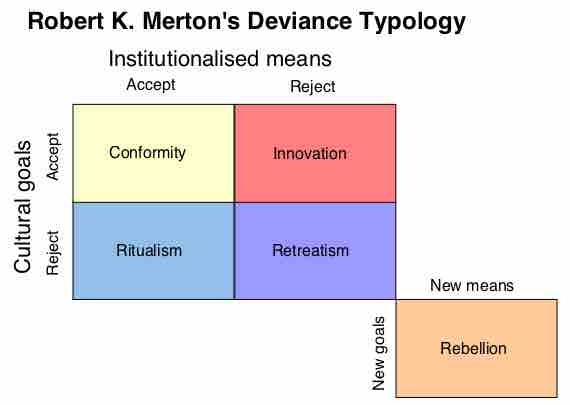Social strain theory was developed by famed American sociologist Robert K. Merton. The theory states that social structures may pressure citizens to commit crimes . Strain may be structural, which refers to the processes at the societal level that filter down and affect how the individual perceives his or her needs. Strain may also be individual, which refers to the frictions and pains experienced by an individual as he or she looks for ways to satisfy individual needs. These types of strain can insinuate social structures within society that then pressure citizens to become criminals.

Social Strain Theory
Five types of deviance.
In his discussion of deviance Merton proposed a typology of deviant behavior that illustrated the possible discrepancies between culturally defined goals and the institutionalized means available to achieve these goals. A typology is a classification scheme designed to facilitate understanding. In this case, Merton was proposing a typology of deviance based upon two criteria: (1) a person's motivations or his adherence to cultural goals; (2) a person's belief in how to attain his goals. According to Merton, there are five types of deviance based upon these criteria:
- Conformity involves the acceptance of the cultural goals and means of attaining those goals.
- Innovation involves the acceptance of the goals of a culture but the rejection of the traditional and/or legitimate means of attaining those goals. For example, a member of the Mafia values wealth but employs alternative means of attaining his wealth; in this example, the Mafia member's means would be deviant.
- Ritualism involves the rejection of cultural goals but the routinized acceptance of the means for achieving the goals.
- Retreatism involves the rejection of both the cultural goals and the traditional means of achieving those goals.
- Rebellion is a special case wherein the individual rejects both the cultural goals and traditional means of achieving them but actively attempts to replace both elements of the society with different goals and means.
What makes Merton's typology so fascinating is that people can turn to deviance in the pursuit of widely accepted social values and goals. For instance, individuals in the U.S. who sell illegal drugs have rejected the culturally acceptable means of making money, but still share the widely accepted cultural value in the U.S. of making money. Thus, deviance can be the result of accepting one norm, but breaking another in order to pursue the first. In this sense, according social strain theory, social values actually produce deviance in two ways. First, an actor can reject social values and therefore become deviant. Additionally, an actor can accept social values but use deviant means to realize them.
Critics point to the fact that there is an ample amount of crime/delinquent behavior that is "non-utilitarian, malicious, and negativistic" (O'Grady, 2011), which highlights that not all crimes are explicable using Merton's theory. Crimes such as vandalism, for example, can't be explained by a need for material acquisition.